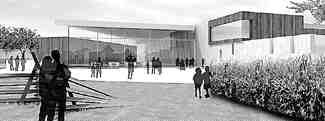
|
||||||
|
Region's $22.7 M history museum will embrace crossroads theme |
||||||
|
March 28, 2008 by FRANCES BARRICK
WATERLOO REGION
DRAWING BY MORIYAMA & TESHIMA ARCHITECTS The spot where Waterloo Region's settlement road converges with the old rail line will be home to a $22.7-million regional museum. "This physical crossroad serves as a powerful design metaphor for a museum," architect Diarmuid Nash said yesterday. The Toronto architectural firm of Moriyama & Teshima and the Walter Fedy Company of Kitchener were hired to design the museum, to be built at Doon Heritage Crossroads, off Homer Watson Boulevard in Kitchener. Yesterday, reporters got a "sneak peek" of the Region of Waterloo History Museum. Three project open houses will be held next week. The museum will go up at the intersection of two historical settlement routes. Huron Road was built in the 1830s to bring settlers into the region. The rail line connected Kitchener and Cambridge and beyond to Goderich. The "crossroads theme" will also be incorporated into the design of the 42,000-square-foot building, said project architect Brian Rudy, a descendant of one of the region's founding settlers, Joseph Schoerg. Huron Road will become the pathway to the museum and rail lines will be embedded in the entrance, he said. The entrance will form a crossroads, where visitors can either go into the lobby, theatre or classrooms, visit the galleries exhibiting some of the museum's 43,000 artifacts, or go outside and tour existing buildings depicting 1912 village life. "The building opens up like a book," Rudy said. To be built of wood, brick and stone, the museum will also feature skylights and a large picture window, which will act as a mirror, reflecting the outdoor village setting. Four existing buildings will be demolished to make way for the museum. The buildings, which don't have historical value, are the Waterloo County Township Hall, the Waterloo County Hall of Fame, a gift shop and washrooms. A reproduction of the township hall will be part of the living village. Artifacts from the hall of fame will be placed in the new museum. The museum project has been especially meaningful for Rudy, who was born and raised in Kitchener. His ancestral home was built 200 years ago beside the Pioneer Tower, across the Grand River from Doon Heritage Crossroads. The farmhouse was torn down for a residential development. "It has been a labour of love," Rudy said of the project. The museum may be the first in Canada to use environmentally friendly materials in the construction of displays and to meet the silver standard of the national Leadership in Energy Efficiency and Environmental Design program, said Tom Reitz, curator at Doon Heritage Crossroads. The building must be finished by March 31, 2010, for the museum to get a $2 million federal grant. The region is also applying for provincial grants, but the bulk of the cost will be borne by regional taxpayers. Work on developing exhibits will not be completed until 2011, Reitz said. The museum's official opening is set for July 1, 2012, to coincide with the 100th anniversary of the founding of the Waterloo County Historical Society. The group start collecting artifacts in 1912, the same year Berlin (later Kitchener) was declared a city. See www.region.waterloo.on.ca/museum for more information. © Copyright 2007 Metroland Media Group Ltd. |
||||||
